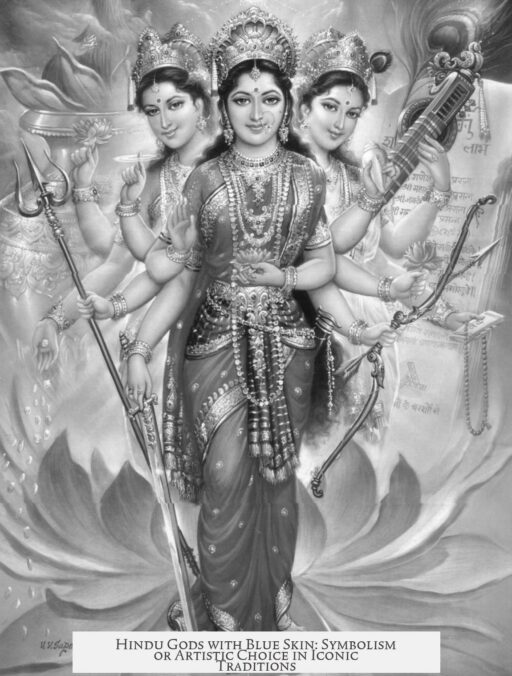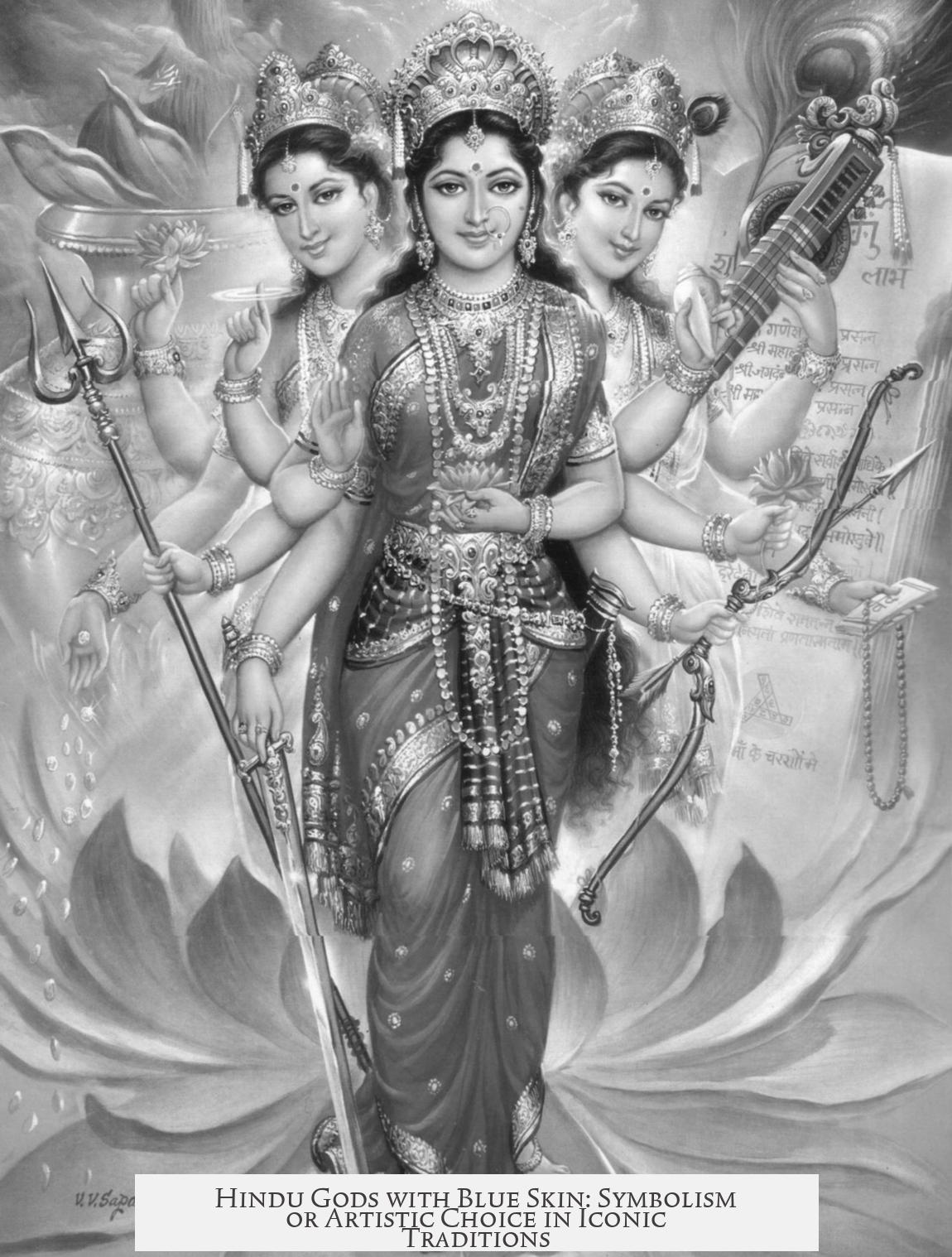Many Hindu gods, especially Lord Vishnu and his avatars, are depicted with blue skin primarily due to traditional interpretations of scriptural descriptions and artistic influences rather than strict symbolic meaning.
Lord Vishnu is described in ancient texts as having the color ‘megha varna,’ meaning the hue of fresh rain clouds. This description does not specify a clear color but suggests a shade related to dark clouds. Traditionally, this has been rendered as black or dark grey in worship images. Sculptures carved from granite, common across regions, naturally take on these dark tones, aligning with Vishnu’s scriptural depiction.
However, the prevalent blue skin portrayal gained prominence during the Mughal period, particularly under Emperor Akbar. An apocryphal story suggests that Akbar decided on blue to interpret ‘megha varna’ because artists were uncertain how to depict the rain-cloud shade. Mughal miniature paintings show Krishna, an avatar of Vishnu, with blue skin. This artistic style influenced later religious art, popularizing blue skin for Vishnu and his avatars.
This Mughal artistic influence extended to other deities as well. For instance, Goddess Kali, originally described as pitch black, is often shown with deep blue skin. Hence, blue skin depictions became more an aesthetic choice rooted in historical artistry than a fixed symbolic convention.
Many other Hindu gods do not commonly appear with blue skin. Lords like Shiva are sometimes portrayed with blue tones, but it varies significantly and lacks the consistent scriptural or artistic backing that Vishnu’s imagery possesses.
| Factor | Explanation |
|---|---|
| Scriptural Description | “Megha varna” suggests cloud-like dark hues, not strictly blue. |
| Material Constraints | Granite carvings naturally align with black/dark grey tones. |
| Mughal Influence | Akbar’s patronage led to blue depiction in miniatures, spreading to religious art. |
| Artistic Popularity | Blue skin became a recognizable aesthetic, extending to other deities. |
- Blue skin in Hindu deities mainly applies to Vishnu and avatars.
- Original texts describe Vishnu’s skin as cloud-colored, ambiguous in hue.
- Mughal-era art standardized blue skin imagery, influencing popular depictions.
- Blue is more artistic tradition than strict symbolic meaning.
Why Do So Many Hindu Gods Have Blue Skin? Symbolism or Artistic Choice?
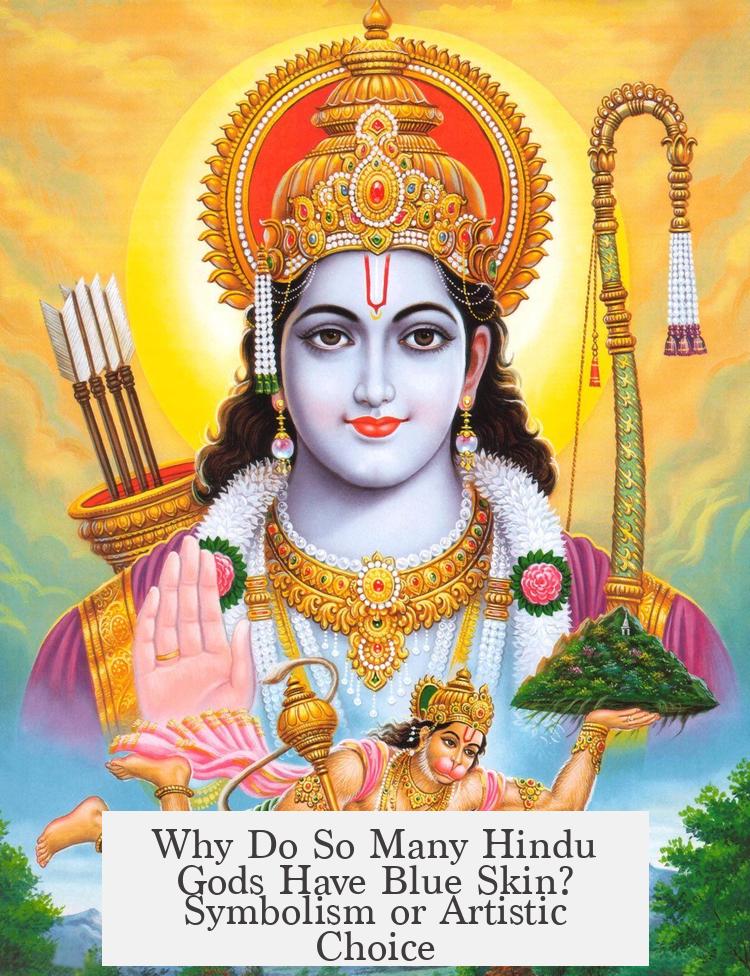
Why are many Hindu gods portrayed with blue skin? Is it symbolic or just an artistic whim? The quick answer: it’s a bit of both, but largely an artistic and historical development rather than a fixed spiritual rule. The fascinating journey behind the blue skin reveals layers of scriptural nuance, material practicality, and influential artistic trends.
Let’s dive deep and unpack the mystery!
The Blue-Hued Gods: Who Are They Anyway?
When you think of Hindu deities with blue skin, Lord Vishnu and his avatars come immediately to mind. Lord Krishna, the enchanting prince, is famously blue. Lord Rama too. These blue hues are much more common in depictions of Vishnu and his incarnations.
What about other gods? Well, some portrayals of Lord Shiva also show a bluish tinge, especially in artistic renditions. Yet, this is not consistent. Buddha and Ganesha, for example, are usually depicted with natural skin tones or different colors entirely. So, the blue skin is not a universal divine standard.
The Scriptural Clue: Megha Varna or Color of Rain Clouds
The root of this blue skin story lies in ancient scriptures. Vishnu is described as “megha varna”, meaning “color of fresh rain clouds.” Now, cloud color is tricky—it isn’t straightforward blue, more of a dark, sometimes grayish hue.
Imagine trying to paint a cloud. It’s not exactly pure blue—sometimes more subdued, shifting with light and shadow.
Traditionally, this description led artists and sculptors to render Vishnu in darker shades, often black or deep gray, aligning well with the natural color of granite, the most popular material for sacred statues. Granite’s natural dark gray or near-black shades made it practical for temple idols, converting “megha varna” into visible, tactile art pieces.
Now Enter Mughal Influence: Emperor Akbar’s Color Choice
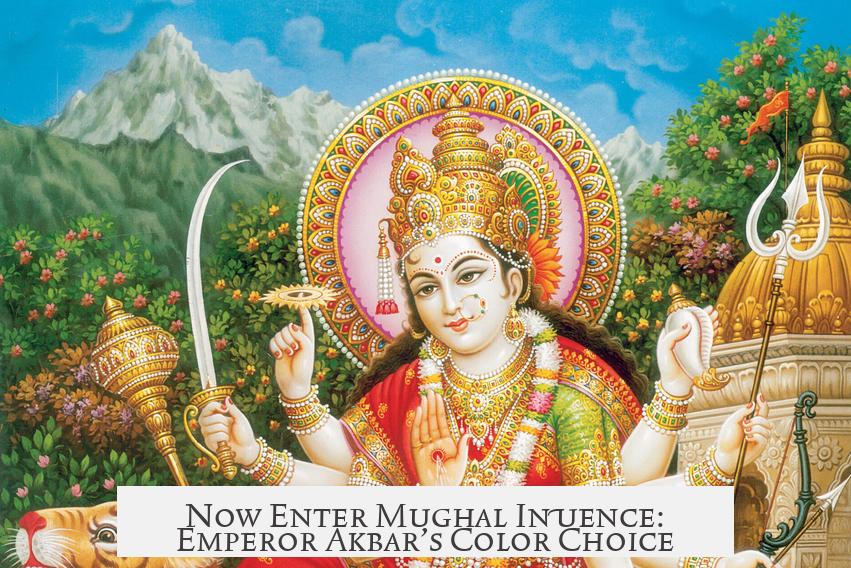
Here’s where it gets juicy. Many art historians believe the now-iconic blue skin portrayal materialized in medieval times, strongly influenced by the Mughal empire, particularly Emperor Akbar.
An intriguing story (though apocryphal, meaning it’s not officially documented) suggests Akbar himself decided to interpret “megha varna” as blue. Why? Maybe the artists were stumped, and the emperor’s artistic mandate marched in. The Mughal miniatures, delicate and colorful, often showed Krishna and some divine figures in blue.
Think of it as a royal decree that set a new style standard, making blue skin “official” in popular depictions.
Why Blue Then? More Than Meets the Eye
But why blue? Beyond the practicality of cloud color or royal whims, blue holds special significance across many cultures. It’s the color of the sky and ocean — vast, infinite, and mysterious. Blue symbolizes divinity, peace, and infinity, which fits gods meant to embody cosmic order and eternal truth.
So while not originally codified in scripture, blue became symbolically rich, aligning well with the gods’ transcendental nature over time.
Blue Bleeds Into Other Deities and Art Forms
The Mughal influence didn’t stop with Vishnu and Krishna. Other deities, like Goddess Kali, who is described as pitch black, often appear in deep blue shades in popular art. This blending likely stems from cultural cross-pollination and aesthetic preferences from the same era.
Blue skin increasingly became a shorthand for divine power, mystical presence, and otherworldliness when painted or sculpted.
Summary: Blue Skin — More Art than Doctrine
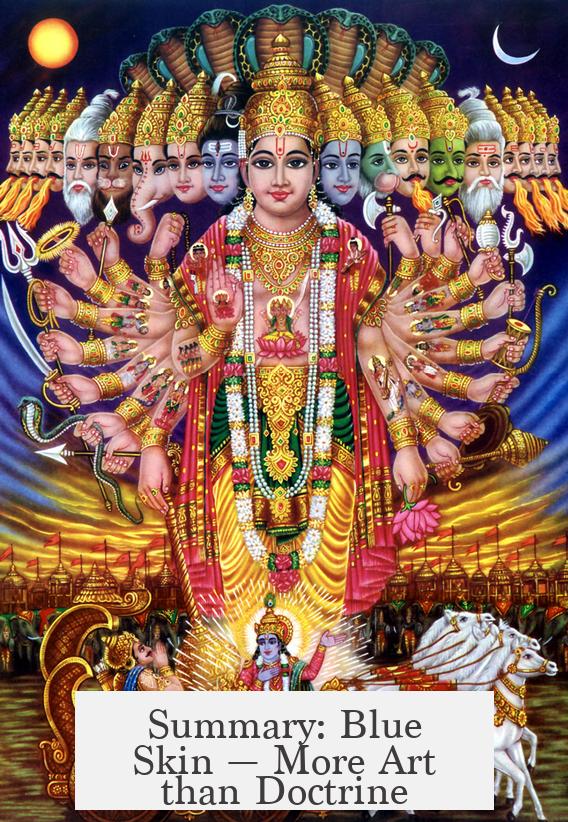
| Factor | Explanation |
|---|---|
| Scriptural Description | “Megha varna” (cloud-colored) suggests a dark, ambiguous color, not strictly blue. |
| Material Considerations | Granite statues traditionally dark gray/black influenced portrayals close to scriptural hints. |
| Mughal Artistic Influence | Akbar’s artistic decisions and Mughal miniatures popularized vibrant blue depictions. |
| Symbolic Extension | Blue came to symbolize divine infinity and mysticism in popular Hindu art. |
What Can We Learn from This Blue-Hued Tale?
Knowing this blends history, art, and theology helps us appreciate Hindu iconography beyond the surface.
Next time you see a blue-skinned god, remember it isn’t merely an artistic whim or random fantasy. It’s a rich story of linguistic nuance, royal art trends, and symbolic layering that evolved over centuries.
Is blue skin the “true color” of divinity? Maybe not literally. But it captures much more — the infinite nature of the divine, the mysterious depth of cosmic order, and an artistic dialogue between cultures.
Practical Tips for Art Lovers and Cultural Enthusiasts
- When exploring Hindu art, research regional traditions—blue skin depictions vary across India.
- Check the medium: stone carvings versus paintings often differ in color choices.
- Look for Mughal miniature styles if you want to see the origins of blue-skinned depictions closely.
- Remember that colors in religious art often serve multiple roles: symbolic, practical, and aesthetic.
Curious about other iconic color choices in religious art? What about why Buddha is often golden or why Shiva sometimes has ash-white skin? Each story tells us about faith, culture, and the human touch on the divine.
In the end, with Hindu gods’ blue skin, it’s a wonderful fusion of poetic scriptural imagery, artistic innovation, and cultural influences. The blue is more than just paint; it’s an emblem of mythology’s layered depths.
Why are Hindu gods like Vishnu shown with blue skin?
Vishnu is described in texts as ‘megha varna,’ meaning the color of fresh rain clouds. This doesn’t match a simple color, but artists often picked blue to represent this ambiguous shade.
Is the blue skin symbolic or just an artistic choice?
The blue color is more artistic than symbolic. It arose from scriptural ambiguity and practical art choices, plus influence from Mughal paintings, rather than a strict symbolic meaning.
Did Mughal rulers influence the blue portrayal of Hindu gods?
Yes. An apocryphal story credits Emperor Akbar for endorsing artists to depict Vishnu as blue, blending Hindu and Mughal artistic traditions, which popularized the blue depictions.
Are all Hindu deities portrayed with blue skin?
No. Blue is mainly linked to Vishnu and his avatars. Other gods like Shiva are sometimes shown blue, but this is less common and mostly due to artistic preference.
Why is Goddess Kali sometimes shown with blue skin instead of black?
Kali is described as pitch black in texts. However, Mughal-influenced art often shows her in deep blue, extending the blue shading tradition beyond Vishnu’s avatars.
